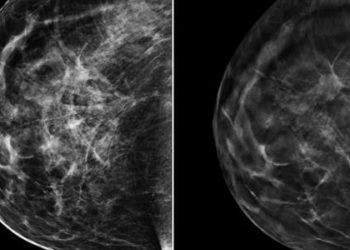Radiofrequency tags may safely localize nonpalpable breast lesions
1. This study’s finding indicate that radiofrequency identification tags may be a safe and effective method of preoperative, wireless localization of nonpalpable breast lesions, without localization failures or postoperative infection.
2. Breast resections occurring with radiofrequency guidance were confirmed by successful detection of the identification tags in excised specimens.
Evidence Rating Level: 2 (Good)
Study Rundown: Breast cancer is the second most commonly diagnosed cancer, affecting 1 in 8 women in the United States. A common procedure in the treatment of nonpalpable breast tumors is surgical excision, typically preceded by insertion of a wire and hook into the lesion to direct tumor removal. Wire localization may be complicated by procedural pain and inconsistent accuracy, warranting research into alternative techniques. Radiofrequency identification is an emerging tool which may allow for precise tissue location using implanted radiofrequency tags to mark the excisional site, avoiding the standard wire which may either migrate or cause pain following insertion. The current study was a small pilot evaluation of such radiofrequency identification tags as a localization method for nonpalpable breast lesions. The primary focus was on the safety of the technique as defined by tag migration and postoperative infection within 30 days, while also examining localization capability through successful removal of the lesion itself without intralesional loss of the tag. Radiofrequency identification was found to reliably locate the lesions without tag migration from the placement site, as confirmed by excisional specimens, with no reported postoperative infections. As a small pilot study, limitations were primarily related to the small sample size. Future studies should examine the generalizability of these findings within a larger cohort while additionally determining the duration of safe tag implantation and comparing if radiofrequency tags may reduce excisional volumes relative to wire localizers.
Click to read the study in the American Journal of Roentgenology
Relevant Reading: Radiofrequency identification tags for preoperative tumor localization: proof of concept.
In-Depth [prospective cohort]: Twenty consecutive women of mean age of 53 years all with lesions less than 6 cm in depth from the skin of the breast underwent hook-wire placement and radiofrequency identification tagging immediately prior to surgery. The tag itself is a passive microchip encased within a glass capsule, measuring 2 x 12 mm in size, which is then localized with a handheld wire-loop detection device which reads the unique identification number stored on the microchip. Both hook-wire and radiofrequency identification tag localization was performed in women requiring preoperative localization prior to surgery. The radiofrequency identification tags were used to localize individual breast lesions for surgical excision while the hook wire device was delegated as backup in case of identification tag migration or localization error. Radiofrequency identification tag function within the lesion of interest was assessed with a loop probe against the overlying skin following percutaneous placement of the identification tag. In all 20 subjects, breast lesions were then surgically removed as guided by the radiofrequency identification tag with no postoperative infections occurring within 30 days. No localization failures occurred and each uniquely identifiable tag was confirmed within the excised specimen with hand-held detector. Tag migration was reported in 3 subjects as the lesion was being retracted as a part of the procedure, with no episodes of tag migration reported prior to incision.
Image: PD
©2015 2 Minute Medicine, Inc. All rights reserved. No works may be reproduced without expressed written consent from 2 Minute Medicine, Inc. Inquire about licensing here. No article should be construed as medical advice and is not intended as such by the authors or by 2 Minute Medicine, Inc.







